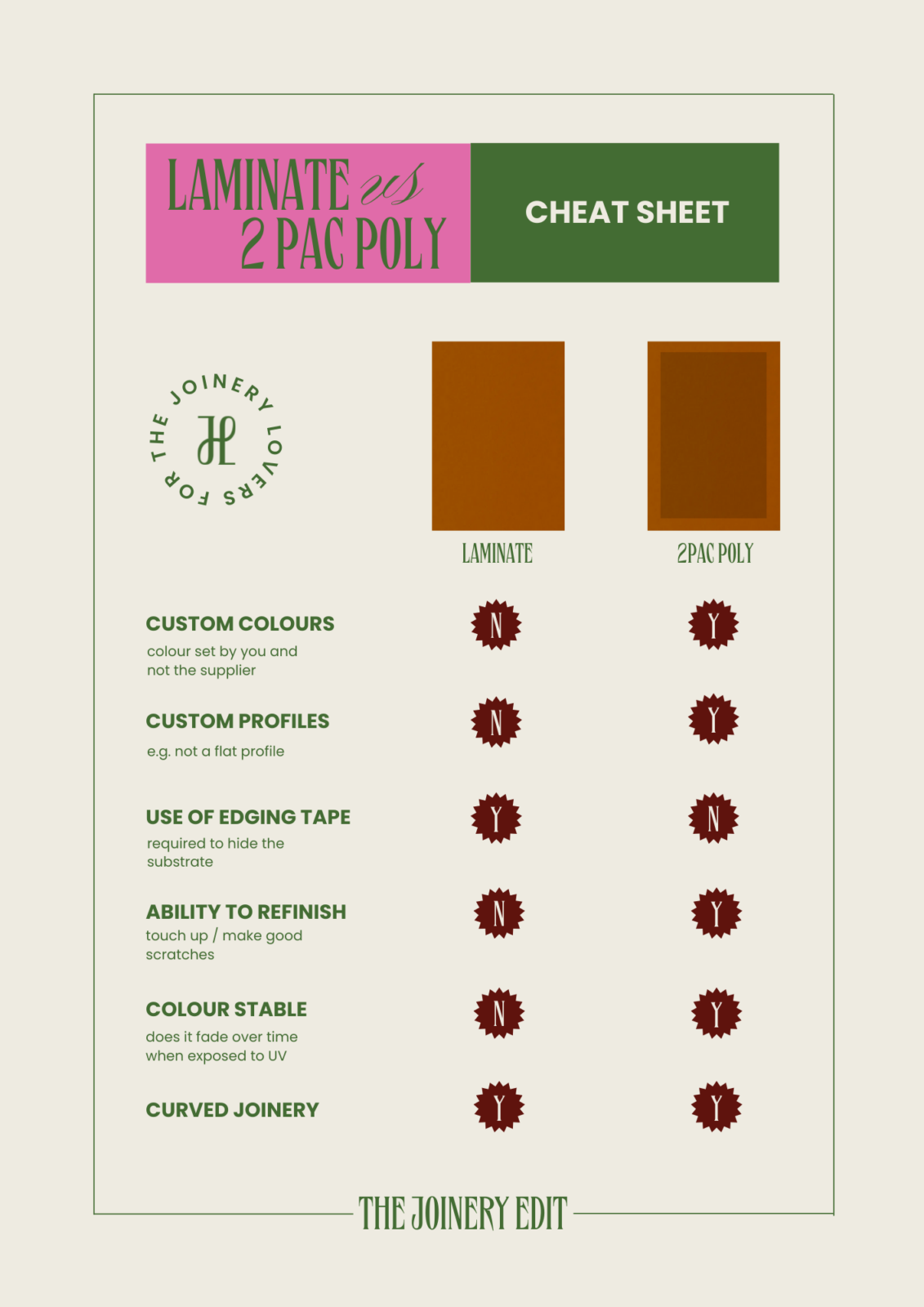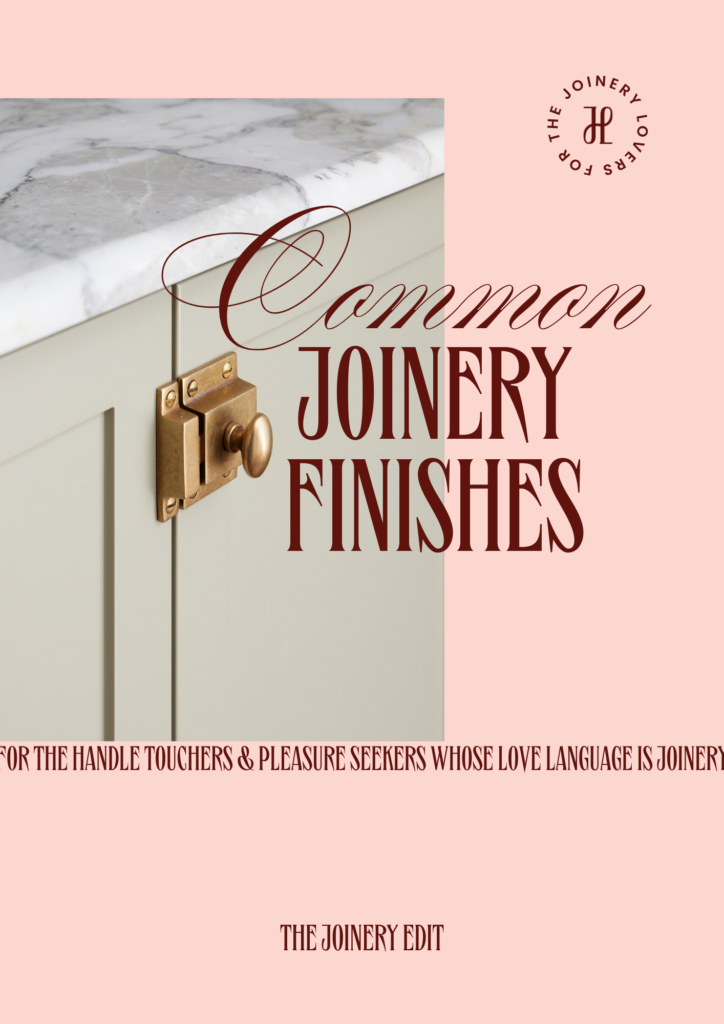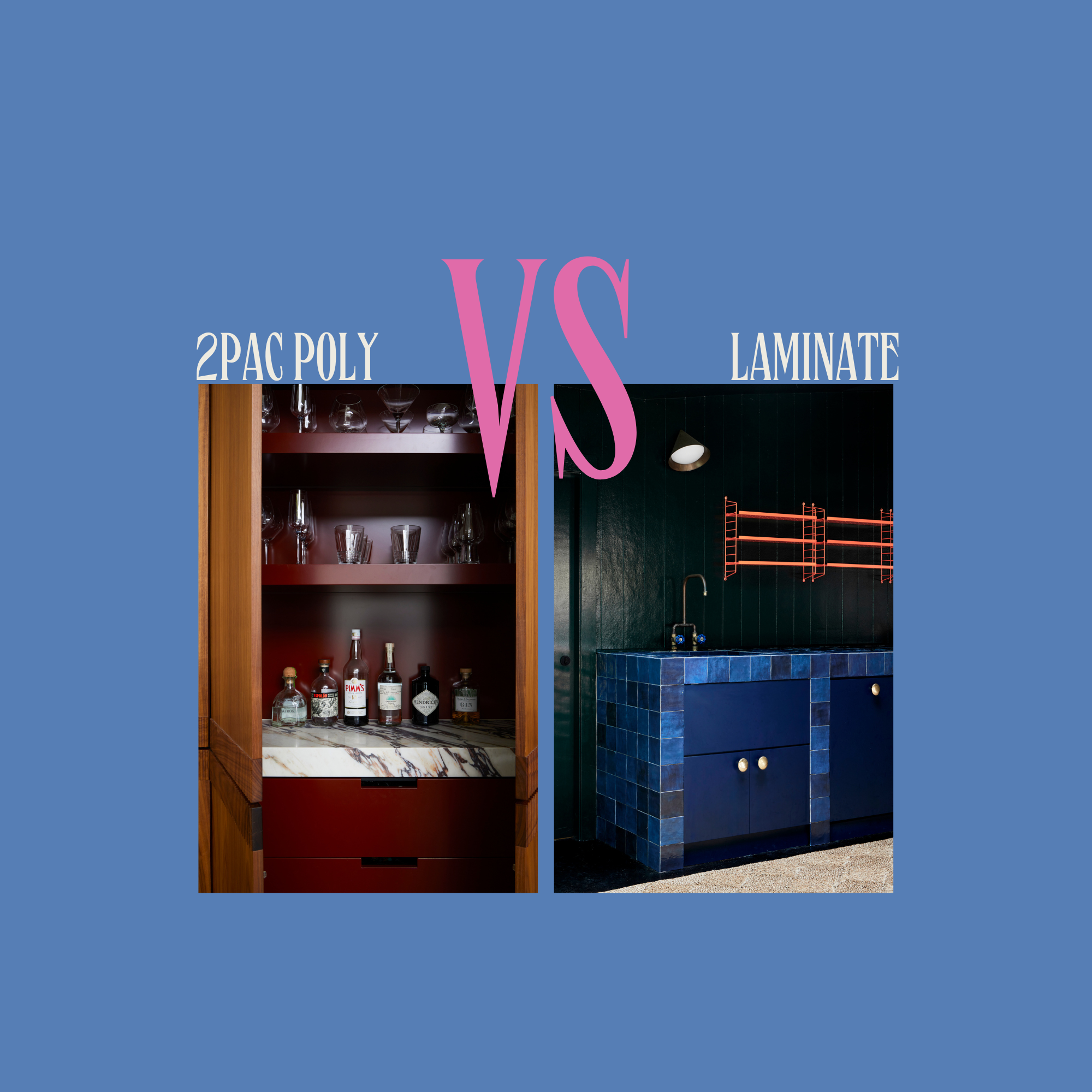Choosing the right finish for your joinery.
Lots of people ask about the main differences between Laminate and 2PAC finishes.
This article will investigate laminate and 2PAC to determine which is better for your application. But here’s the thing, both options have their own strengths and weaknesses, and choosing the right one depends on your needs.
What is laminate?
Laminate is a synthetic product made of several layers of resin-impregnated paper. These are then laminated to form a rigid sheet – typically 1mm thick. Laminate is pressed or contact glued onto an MDF, particle board or plywood substrate.
What is 2pac?
2PAC is a hardened heavy-duty paint finish made of a two-part solution comprising acrylic paint and a resin hardener. A chemical reaction occurs when these two liquids are mixed, causing the mix to harden. This results in a thick, smooth, hard finish – similar to the paint used on cars. 2PAC is applied to MDF or Satin MDF substrate and is a sprayed finish applied in a controlled booth (free of dust).
What are the key differences?
Typical uses
- Laminate can be used for both horizontal and vertical surfaces.
- Laminate can be used as a benchtop, but you must be mindful of placing hot items directly on top (use a trivet).
- 2PAC can be used for both horizontal and vertical surfaces.
- However, when used on horizontal surfaces, this would be for decorative furniture items, not table tops or benchtops.
Door profiles
- Laminate cabinet doors are only available with a flat profile.
- 2PAC is a sprayed finish allowing for any door profile.
Application
- Laminate is a very thin sheet glued onto the substrate, and the exposed edges are finished with ABS edging tape.
- 2PAC is a sprayed application, and the finish is seamless on all edges/faces (no edging tape).
Colours
- Laminates come in an extensive range of colours. However, they can be discontinued (you are at the supplier’s mercy). I still reminisce about the perfect buttery yellow Laminex discontinued.
- 2PAC can be ANY colour and will never be discontinued, as paint colours are formulas that can be recreated repeatedly.
Finishes
- Laminate is available in different finishes depending on the supplier; Matte, low sheen, gloss, fingerprint resistance, etc.
- Laminate is also available in faux timbers, woodgrains and metallics.
- 2PAC standard finishes are 30% satin, 60% semi-gloss and 90% full gloss.
- 30% satin gives just enough gloss level without being overly shiny.
- 2PAC as a finish is FLAT in appearance. To add textural depth, you can apply 2PAC to a timber veneer to accentuate the grain. However, this is an expensive finish; you’re adding 2 separate finishes to the joinery (a veneer which is then applied with 2PAC).
Lifespan
- Laminate is hardwearing. However, it can scratch and chip, and you can’t “spot repair”.
- Laminate uses an edging tape, so over time, this can delaminate. That being said, laminate joinery is exceptionally hardwearing if well cared for.
- 2PAC should generally last you longer than laminate cabinetry; however, it can scratch and chip just like the exterior of a car. It can be touched up, OR you can respray the entire door.
Replacing doors
- Laminate is produced in batches. This can be an issue if you want to replace the damaged door, as you will never get an exact match, and yes, this extends to whites.
- Laminate can fade/discolour over time when in direct sunlight.
- Minor chips in 2PAC can be retouched in situ. Or if the damage is extensive, the entire door can be resprayed.
- 2PAC colour is very stable and highly resistant to fading.
Cost
- Laminate is available in different pricing “bands”. The most cost-effective is a natural (matte) finish. Dark natural finishes are more prone to showing fingerprints than lighter finishes.
- The most expensive laminate ranges are the fingerprint-resistant (absolute matte/venette) and the full gloss finishes.
- 2PAC can be more expensive, BUT this will depend on the laminate finish. The new fingerprint-resistant laminates are comparable to a 2PAC finish.
- The total price of joinery will increase parallel to the amount of detail applied to the joinery (Shaker doors, etc.) As a result, a profiled 2PAC kitchen may cost double the budget of a flat panel laminate kitchen of the equivalent size.
- Darker colours in 2PAC are more expensive than finishes with a light base.
- 90% gloss in 2pac is the most expensive finish due to more preparation work pre-spraying and more buffing post-spraying.

CHEAT sheet
The biggest downside to Laminate is that you can only specify a flat door profile.
However, I’ve said it before, and I’ll repeat it…. again! Never underestimate a flat door profile with an epic handle. This will always be a cost-effective way to make your joinery more unique.
summary
Both finishes have trade-offs and cater to different needs and preferences. The most significant advantage of using a 2PAC finish is the ability to specify any colour, which is vital if you want to match your joinery to your wall colour.
Designers often alter joinery finishes within a project to suit the budget. It is not uncommon to use a 2PAC finish in crucial areas such as kitchens and primary bedrooms/bathrooms and then down spec to Laminate in areas such as laundries.
If you compare a flat white door in a natural laminate finish versus a 30% white satin 2PAC finish, then yes, Laminate will be more cost-effective. However, if you took the same flat door in a navy finish in a Laminate absolute matt (fingerprint resistant) versus a navy 2PAC finish in 30% satin, these would be comparable in price.
Both finishes are relatively low-maintenance, wipe up spills and don’t use abrasive cleaning products.
I cover these finishes in more detail along with other common joinery finishes in this guide.

Common Joinery Finishes Guide
This Guide Is For Those New To The Industry Or Undertaking A Renovation And Don’t Need The Full Signature Finishes Guide. The Guide covers the most commonly and widely used joinery finishes.
Melamine, Laminate, Vinyl Wrapped, Plywood, Two Pac Polyurethane, Hand painted, Timber Veneers and Solid Timber.
Digital Resource Available Here

Comments +